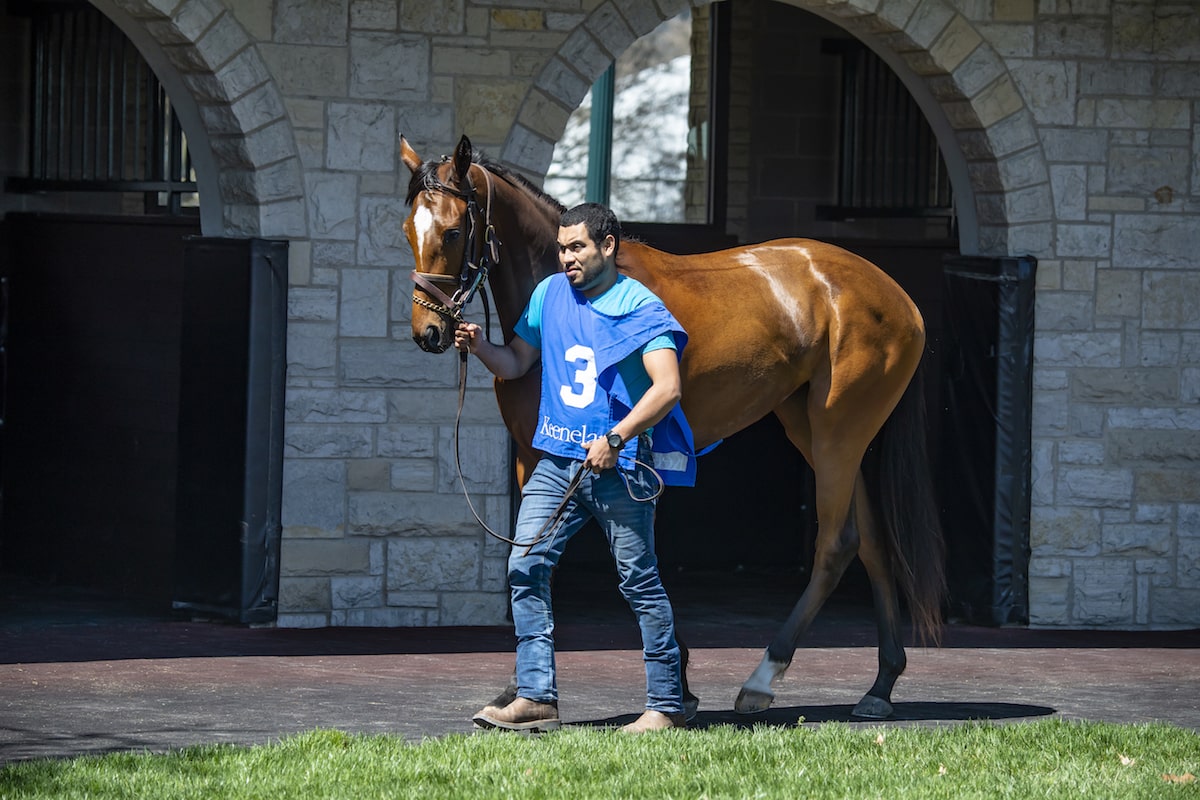
Pyrois Media/Melissa Bauer-Herzog
Garden hoses, mounting blocks and crossties — you’ll find all three at almost any stable, no matter the discipline. But if an off-track Thoroughbred arrives straight from the racetrack, he might never have set eyes on any of them.
An unfamiliarity with these objects might require extra patience and basic training. However, many off-track Thoroughbreds actually have much better manners than their nonracing peers. Racehorses train in a highly organized way, being handled daily according to a strict routine. Some handling techniques are the same as those the horses will encounter in their second careers, while others will need a little tweaking.
Kristin Mulhall works in both worlds. A former grand-prix-level show jumper, she now trains a string of racehorses at major Southern California racetracks. In her spare time she rescues and rehabilitates Thoroughbreds and other horses at her Twilight Farms, in Covina.
Mulhall also retrains horses retired by their owners. Currently she’s working with 2016 Breeders’ Cup Turf Sprint winner Obviously, an earner of more than $2 million whose owners want him to have a good second career.
Sometimes Mulhall acquires Thoroughbreds with illegible lip tattoos and unknown racing histories, so she doesn’t know what they’ve experienced. But no matter their background, she gives them time mentally to acclimate to their surroundings before teaching them new skills.
Bath Time Basics
Something as commonplace as a snaking garden hose could frighten a former racehorse, simply because their daily baths didn’t include one.
“A lot of racetrack barns don’t use a hose — they use a sponge,” says Mulhall. “They will use a bucket of soapy water and a bucket of clean water. And the water is warm.”
Mulhall prefers to use a hose with her racehorses because she feels she can better rinse off all the soap.
“But I’ve gotten plenty of horses off the track that if you turn a hose on their feet, they freak out,” she says. “I’ve seen a lot of barns in Florida that refuse to let the grooms put water on the horses’ feet.”
Some racehorse trainers feel that if horses have their feet hosed off every day, it will make the hooves too soft. So grooms will clean a horse’s feet with brushes instead of water.
Grooming and Tying
With daily care, racehorses become very used to having their feet handled. Often racetrack grooms pick out all the feet while standing on the left (near) side, and horses become adept at having their off-side feet picked up this way.
Mulhall cautioned people to be especially careful when handling racehorses on their right side.
“They always swing their hip to the right because they’re used to everyone being on their left,” she says. “I think it’s safer to pick a racehorse’s hind feet from the same side because when they’re tied up, they will swing that hip over.”
Typically, racetrack grooms tie a horse in the stall for grooming, tacking up, bandaging, etc. That differs from nonracing stables, where people tend to groom horses in crossties or other areas outside the stall.
Racehorses might know about crossties if they were raised at farms or spent time at layup facilities that used them. But don’t assume your OTTB understands these contraptions.
“I just loop the ropes over the crossties without tying them and slowly get them used to it,” says Mulhall. “I start by tying them outside in a pen to get them used to being tied outside of a stall.”
Mulhall uses a hot-walking machine primarily to help horses learn to tie outside (hers involves clipping a horse to a revolving arm, rather than turning him loose between gates). Racehorse stables, particularly smaller ones, might use hot-walking machines, but major operations usually walk all horses by hand every day after their morning training. An employee known as a hot-walker leads the horse through the shedrow or outside the barn in an area specially designated for walking.
Before You Hop On
Trainers also use the outside walking area to walk fully tacked horses before they go to the track for morning training. The trainer gives a leg up to the exercise rider in the mornings. On afternoons when a horse races, the trainer also gives a leg up to the jockey in the racetrack walking ring.
As a result, racehorses are unfamiliar with not only mounting blocks but also weight in the left stirrup as a rider swings up from the ground.
“You cannot put a foot in the stirrup and climb up on them the way a Western rider would,” says Mulhall. “They get a little bit scared sometimes of people over their head. They’ll move away from you or they’ll turn toward you to face you. So you have to have somebody hold them at the mounting block.”
Mulhall also recommends people mount former racehorses quickly until they learn to stand quietly: “Don’t give the horse too much time to think.”
Lessons Already Learned
Riders in English disciplines often braid a horse’s mane for a clean look, and you might think that would be a new experience for your OTTB. But many are already familiar with mane braiding for a much different reason.
When a horse breaks out of the starting gate, it is an explosive move for which the jockey must be ready. Grooms often braid a racehorse’s mane so the jockey can unbraid it on the trip to the starting gate. The kinked mane gives jockeys an extra place to grip.
The race-day routine offers another advantage, especially if a horse’s second career will include showing and associated drug tests. Because racehorses get tested frequently to be sure they have no unlawful medications in their systems, many grooms train them to urinate upon hearing a whistle. Knowing that might save you time in a horse show drug testing situation.
The constant handling of racehorses also includes plenty of hauling experience. Most racing is done on a circuit, with no one track running year-round. Horses van or fly to other locations frequently. Vans are typically large and roomy with ramps. Most racehorses aren’t used to small two-horse trailers, especially step-up trailers.
“You want to have a trailer that’s tall, a Warmblood-sized trailer,” says Mulhall. “I have a slant-load that I absolutely love. It’s extra tall and extra wide, and they all just walk in and load.”
With a slant-load trailer Mulhall can turn a horse around and lead it out, as is done with a racehorse van, instead of having to back the horse out.
Parting Tips
Mulhall suggests owners of off-track Thoroughbreds handle their horses at different hours of the day. A racehorse’s routine at the track is very rigid, and they are used to being left alone in their stalls all afternoon unless racing.
“At a show-horse barn, the horses might get out at any time of the day,” Mulhall says. “If you’re going to show them, you never know when your class is. You don’t want a horse that’s going to get cranky in the stall later in the afternoon. It’s good for them to be outside at different times.”
Knowing the difference between your barn and a typical racing barn can help you help your off-track Thoroughbred adjust to his new routine.

